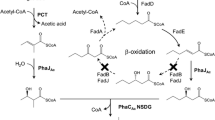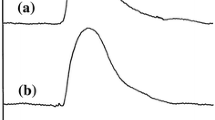Abstract
Burkholderia sp. synthase has been shown to polymerize 3-hydroxybutyrate (3HB), 3-hydroxyvalerate, and 3-hydroxy-4-pentenoic acid monomers. This study was carried out to evaluate the ability of Burkholderia sp. USM (JCM 15050) and its transformant harboring the polyhydroxyalkanoate (PHA) synthase gene of Aeromonas caviae to incorporate the newly reported 3-hydroxy-4-methylvalerate (3H4MV) monomer. Various culture parameters such as concentrations of nutrient rich medium, fructose and 4-methylvaleric acid as well as harvesting time were manipulated to produce P(3HB-co-3H4MV) with different 3H4MV compositions. The structural properties of PHA containing 3H4MV monomer were investigated by using nuclear magnetic resonance and Fourier transform infrared spectroscopy (FTIR). The relative intensities of the bands at 1,183 and 1,228 cm−1 in the FTIR spectra enabled the rapid detection and differentiation of P(3HB-co-3H4MV) from other types of PHA. In addition, the presence of 3H4MV units in the copolymer was found to considerably lower the melting temperature and enthalpy of fusion values compared with poly(3-hydroxybutyrate) (P(3HB)). The copolymer exhibited higher thermo-degradation temperature but similar molecular weight and polydispersity compared with P(3HB).







Similar content being viewed by others
References
Alias Z, Tan IKP (2005) Isolation of palm oil-utilising, polyhydroxyalkanoate (PHA)-producing bacteria by an enrichment technique. Bioresour Technol 96:1229–1234
Anderson AJ, Dawes EA (1990) Occurrence, metabolism, metabolic role and industrial uses of bacterial polyhydroxyalkanoates. Microbiol Rev 54:450–472
Bayari S, Severcan F (2005) FTIR study of biodegradable biopolymers: P(3HB), P(3HB-co-4HB) and P(3HB-co-3HV). J Mol Struct 744–747:529–534
Braunegg G, Sonnleitner B, Lafferty RM (1978) A rapid gas chromatographic method for the determination of poly-β-hydroxybutyric acid in microbial biomass. Eur J Appl Microbiol 6:29–37
Braunegg G, Lefebvre G, Genser KF (1998) Polyhydroxyalkanoates, biopolyesters from renewable resources: physiological and engineering aspects. J Biotechnol 65:127–161
Chee J-Y, Tan YF, Samian M-R, Sudesh K (2010) Isolation and characterization of a Burkholderia sp. USM (JCM15050) capable of producing polyhydroxyalkanoate (PHA) from triglycerides, fatty acids and glycerols. J Polym Environ 18:584–592
Chen GQ (2009) A microbial polyhydroxyalkanoates (PHA) based bio- and materials industry. Chem Soc Rev 38:2434–2446
Chia K-H, Ooi T-F, Saika A, Tsuge T, Sudesh K (2010) Biosynthesis and characterization of novel polyhydroxyalkanoate polymers with high elastic property by Cupriavidus necator PHB¯4 transformant. Polym Degrad Stab 95:2226–2232
Doi Y, Kitamura S, Abe H (1995) Microbial synthesis and characterization of poly(3-hydroxybutyrate-co-3-hydroxyhexanoate). Macromol 28:4822–4828
Fukui T, Doi Y (1998) Efficient production of polyhydroxyalkanoates from plant oils by Alcaligenes eutrophus and its recombinant strain. Appl Microbiol Biotechnol 49:333–336
Haywood GW, Anderson AJ, Williams GA, Dawes EA, Ewing DF (1991) Accumulation of a poly (hydroxyalkanoate) copolymer containing primarily 3-hydroxyvalerate from simple carbohydrate substrates by Rhodococcus sp. NCIMB 40126. Int J Biol Macromol 13:83–88
Kahar P, Tsuge T, Taguchi K, Doi Y (2004) High yield production of polyhydroxyalkanoates from soybean oil by Ralstonia eutropha and its recombinant strain. Polym Degrad Stab 83:79–86
Keenan TM, Tanenbaum SW, Stipanovic AJ, Nakas JP (2004) Production and characterization of poly-β-hydroxyalkanoate copolymers from burkholderiacepacia utilizing xylose and levulinic acid. Biotechnol Prog 20:1697–1704
Khanna S, Srivastava AK (2005) Recent advances in microbial polyhydroxyalkanoates. Process Biochem 40:607–619
Lau N-S, Chee J-Y, Tsuge T, Sudesh K (2010) Biosynthesis and mobilization of a novel polyhydroxyalkanoate containing 3-hydroxy-4-methylvalerate monomer produced by Burkholderia sp. USM (JCM15050). Bioresour Technol 101:7916–7923
Lee SY (1996) Plastic bacteria? Progress and prospects for polyhydroxyalkanoate production in bacteria. Trends Biotechnol 14:431–438
Madison LL, Huisman GW (1999) Metabolic engineering of poly(3-hydroxyalkanoates): from DNA to plastic. Microbiol Mol Biol Rev 63:21–53
Reddy CSK, Rashmi RG, Kalia VC (2003) Polyhydroxyalkanoates: an overview. Bioresour Technol 87:137–146
Rehm BHA (2007) Biogenesis of microbial polyhydroxyalkanoate granules: a platform technology for the production of tailor-made bioparticles. Curr Issues Mol Biol 9:41–62
Rehm BHA, Steinbüchel A (1999) Biochemical and genetic analysis of PHA synthases and other proteins required for PHA synthesis. Int J Biol Macromol 25:3–19
Rehm BHA, Steinbüchel A (2002) PHA synthases: the key enzymes of PHA synthesis. In: Doi Y, Steinbüchel A (eds) Biopolymers. Wiley, Weinheim, pp 173–215
Rodrigues MFA, Valentin HE, Berger PA, Tran M, Asrar J, Gruys KJ, Steinbüchel A (2000) Polyhydroxyalkanoate accumulation in Burkholderia sp.: a molecular approach to elucidate the genes involved in the formation of two homopolymers consisting of short-chain-length 3-hydroxyalkanoic acids. Appl Microbiol Biotechnol 53:453–460
Schubert P, Steinbüchel A, Schlegel HG (1988) Cloning of the Alcaligens eutrophus genes for the synthesis of poly-ß-hydroxybutyric acid (PHB) and synthesis of PHB in Escherichia coli. J Bacteriol 170:5837–5847
Steinbüchel A, Lütke-Eversloh T (2003) Metabolic engineering and pathway construction for biotechnological production of relevant polyhydroxyalkanoates in microorganisms. Biochem Eng J 16:81–96
Sudesh K, Doi Y (2005) Polyhydroxyalkanoates. In: Bastioli C (ed) Handbook of biodegradable polymers. Rapra Technology Limited, Shrewsbury, pp 219–241
Sudesh K, Iwata T (2008) Sustainability of biobased and biodegradable plastics. Clean 36:433–442
Tanadchangsaeng N, Kitagawa A, Yamamoto T, Abe H, Tsuge T (2009) Identification, biosynthesis and characterization of polyhydroxyalkanoate copolymer consisting of 3-hydroxybutyrate and 3-hydroxy-4-methylvalerate. Biomacromolecules 10:2866–2874
Tsuge T, Saito Y, Kikkawa Y, Hiraishi T, Doi Y (2004) Biosynthesis and compositional regulation of poly[(3-hydroxybutyrate)-co-(3-hydroxyhexanoate)] in recombinant Ralstonia eutropha expressing mutated polyhydroxyalkanoate synthase genes. Macromol Biosci 4:238–242
Wang YJ, Hua FL, Tsang YF, Chan SY, Sin SN, Chua H, Yu PHF, Ren NQ (2007) Synthesis of PHAs from waster under various C:N ratios. Bioresour Technol 98:1690–1693
Xu J, Guo BH, Yang R, Wu Q, Chen GQ, Zhang ZM (2002) In situ FTIR study on melting and crystallization of polyhydroxyalkanoates. Polymer 43:6893–6899
Acknowledgments
We thank Ms. Janice Neoh Chia-Wee for her help during the execution of this project. This work was supported by a short-term research grant from the Universiti Sains Malaysia. N. S. Lau thanks Universiti Sains Malaysia Fellowship for the financial support.
Author information
Authors and Affiliations
Corresponding author
Rights and permissions
About this article
Cite this article
Lau, NS., Tsuge, T. & Sudesh, K. Formation of new polyhydroxyalkanoate containing 3-hydroxy-4-methylvalerate monomer in Burkholderia sp.. Appl Microbiol Biotechnol 89, 1599–1609 (2011). https://doi.org/10.1007/s00253-011-3097-6
Received:
Revised:
Accepted:
Published:
Issue Date:
DOI: https://doi.org/10.1007/s00253-011-3097-6




